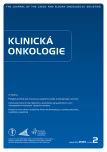HPV 16 in Pathogenesis of Upper Aerodigestive Tract Tumors
Authors:
Barbora Uhliarová 1; Michal Smitka 2
Authors place of work:
Oddelenie otorinolaryngológie, Fakultná nemocnica s poliklinikou F. D. Roosevelta, Banská Bystrica, Slovenská republika 2 Martinské bioptické centrum, s. r. o., Banská Bystrica, Slovenská republika
1
Published in the journal:
Klin Onkol 2020; 33(2): 132-137
Category:
Původní práce
doi:
https://doi.org/10.14735/amko2020132
Summary
Introduction: Human papillomavirus (HPV) is the world’s most widely sexually transmitted disease. HPV infection play also an important role in the etiopathogenesis of head and neck cancers, especially oropharynx.
Material and methods: In a prospective study of 236 patients with squamous cell carcinoma (SCC) of the upper aerodigestive tract (oral cavity, oropharynx, hypopharynx, and larynx), the incidence of p16 positivity in tumor tissue and its relationship to tumor localization, occurrence of risk factors (smoking, alcohol, and sexual behavior), histopathological findings, and stage of disease were analyzed.
Results: Smoking and alcohol abuse were observed in 72% of patients with SCC of the upper aerodigestive tract. Risky sexual behavior was present only in the group of patients with orofaryngeal SCC (42%). Immunohistochemical staining revealed that p16 was present in 20% tumors of upper aerodigestive tract, most frequently in the oropharynx (30%). Patients with p16 positive orofaryngeal SCC were younger, and 94% of these pateints admitted risky sexual behavior. Smoking and regular alcohol consumption were more common in patients with p16 negative SCC of the oropharynx (90%).
Conclusion: HPV 16 infection plays a role in the etiopathogenesis of oropharyngeal carcinoma. In other locations of the upper aerodigestive tract, smoking and alcohol abuse are major risk factors. Determination of HPV status in oropharyngeal SCC is an integral part of histopathological examinations. Immunohistochemical detection of p16 protein expression in tumor tissue is considered sufficient to stratify patients into HPV positive/negative groups of oropharyngeal carcinoma.
The authors declare they have no potential conflicts of interest concerning drugs, products, or services used in the study.
The Editorial Board declares that the manuscript met the ICMJE recommendation for biomedical papers.
Keywords:
risk factors – head and neck cancer – oropharyngeal carcinoma – etiopathogenesis – HPV infection
Zdroje
1. Sehnal B, Podlešák T, Kmoníčková E et al. Anogenitální HPV infekce jako potenciální rizikový faktor orofaryngeálního karcinomu. Klin Onkol 2018; 31 (2): 103–109. doi: 10.14735/amko2018103.
2. Sehnal B, Rozsypal H, Nipčová M et al. Prevalence, incidence, perzistence a možnosti prenosu infekce lidským papilomavirem (HPV). Epidemiol Mikrobiol Imunol 2017; 66 (4): 198–209.
3. Štefanička P. Ľudským papilomavírusom asociovaný karcinóm orofaryngu. Onkologia (Bratisl.) 2015; 10 (3): 189–192.
4. Young D, Xiao CC, Murphy B et al. Increase in head and neck cancer in younger patients due to human papillomavirus (HPV). Oral Oncol 2015; 51 (8): 727–730. doi: 10.1016/j.oraloncology.2015.03.015.
5. El-Naggar AK, Chan JK, Grandis JR et al. WHO classification of head and neck tumours. 4th ed. Lyon: WHO Press 2017.
6. Binková H, Horáková Z, Kostřica R et al. Narůstající incidence HPV pozitivních orofaryngeálních karcinomů. Otorinolaryng a Foniat (Prague) 2015; 64 (4): 205–212.
7. Abogunrin S, Di Tanna GL, Keeping S et al. Prevalence of human papillomavirus in head and neck cancers in European populations: a meta-analysis. BMC Cancer 2014; 14: 968. doi: 10.1186/1471-2407-14-968.
8. Syrjänen S. HPV infections and tonsillar carcinoma. J Clin Pathol 2004; 57 (5): 449–455. doi: 10.1136/jcp.2003.008656.
9. Partlová S, Bouček J, Kloudová K et al. Imunitní systém u pacientů s nádory hlavy a krku. Klin Onkol 2015; 28 (Suppl 4): 86–94. doi: 10.14735/amko20154S86.
10. Brierley JD, Gospodarowicz MK, Wittekind CH et al. TNM classification of malignant tumours. 8th ed. Oxford: Wiley Blackwell 2017.
11. Švajdler M, Laco J, Ondič O et al. HPV-asociované karcinómy hlavy a krku: Aktualizácia poznatkov a odporúčania pre prax. Cesk Patol 2016; 52 (3): 130–138.
12. Kašpírková J, Ondič O, Černá K et al. Možnosti průkazu biologicky relevantní papilomavirové infekce u maligních nádorů hlavy a krku v diagnostické patologii. Cesk Patol 2013; 49 (1): 29–34.
13. Bishop JA, Lewis JS Jr, Rocco JW et al. HPV-related squamous cell carcinoma of the head and neck: An update on testing in routine pathology practice. Semin Diagn Pathol 2015; 32 (5): 344–351. doi: 10.1053/j.semdp.2015.02. 013.
14. Grøn øj Larsen C, Gyldenløve M, Jensen DH et al. Correlation between human papillomavirus and p16 overexpression in oropharyngeal tumours: a systematic review. Br J Cancer 2014; 110 (6): 1587–1594. doi: 10.1038/bjc.2014.42.
Štítky
Detská onkológia Chirurgia všeobecná OnkológiaČlánok vyšiel v časopise
Klinická onkologie

2020 Číslo 2
- Metamizol jako analgetikum první volby: kdy, pro koho, jak a proč?
- Nejasný stín na plicích – kazuistika
- Fixní kombinace paracetamol/kodein nabízí synergické analgetické účinky
- Antidepresivní efekt kombinovaného analgetika tramadolu s paracetamolem
- Geriatrická křehkost a léčba bolesti
Najčítanejšie v tomto čísle
- Karcinom děložního hrdla
- Pohybová liečba ako prevencia a podporná liečba onkologických ochorení
- Metformin in Oncology – How Far Is Its Repurposing as an Anticancer Drug?
- HPV 16 v patogenéze nádorov horného aerodigestívneho traktu
